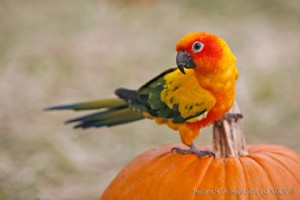
November is a great month for those of us who love birds! Why do I say that? Because we celebrate a very special bird at the end of month. The Native Americans know it as the earth eagle — others know it as the wild turkey! The wild turkey has a long history of association with spirituality and the honoring of the Earth Mother. It is a symbol of all the blessings that the Earth contains. It is truly an American bird that provides us sustenance and allows us a time to reflect and give thanks.
November is also the month of harvesting the great bounty of the earth, including fall-season foods that are good for our companion birds to eat! Let’s start with the foods that are good for our birds at this Thanksgiving time!
1. Pumpkin
 Pumpkin refers to certain cultivars of squash, most commonly those of Cucurbita pepo. Pumpkins, like other squash, are native to North America. Pumpkins are widely grown for food. Pumpkin pie, for instance, is a traditional part of Thanksgiving meals. And it can be part of our bird’s meal, too. Research indicates that phytochemicals found in pumpkin may favorably affect insulin and glucose levels in laboratory diabetes models. The flesh of the pumpkin is an excellent source of many natural poly-phenolic flavonoid compounds such as A, ß carotenes, cryptoxanthin, lutein and zeaxanthin.
Pumpkin refers to certain cultivars of squash, most commonly those of Cucurbita pepo. Pumpkins, like other squash, are native to North America. Pumpkins are widely grown for food. Pumpkin pie, for instance, is a traditional part of Thanksgiving meals. And it can be part of our bird’s meal, too. Research indicates that phytochemicals found in pumpkin may favorably affect insulin and glucose levels in laboratory diabetes models. The flesh of the pumpkin is an excellent source of many natural poly-phenolic flavonoid compounds such as A, ß carotenes, cryptoxanthin, lutein and zeaxanthin.
Carotenes are converted into vitamin A, important for health of the epithelial tissues and the eye. Epithelial tissues that need a constant source of vitamin A include the lining of the respiratory tract, the intestinal tract, oviduct and the tubes that make up the kidney’s filtration system. Vitamin A is needed to allow the cells to differentiate properly — an important requirement of healthy tissues. Pumpkin-seed oil is also rich in omega 3 fatty acids that support immune health along with heart health!
Zeaxanthin, a natural antioxidant, is found in pumpkin. This antioxidant is able to filter UV (ultra-violet) rays and is important in the protection of the macula lutea in the retina of the eyes. Pumpkin is also a good source of B-complex group of vitamins like folates, niacin, vitamin B-6 (pyridoxine), thiamin and pantothenic acid. Pumpkin is also a rich source of minerals like copper, calcium, potassium and phosphorus.
2. Pecans
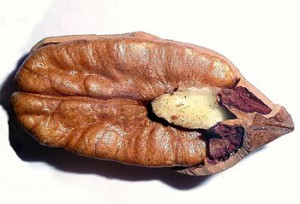 Pecans have a delicious nutty flavor, but are technically a fruit called a drupe. The raw pecans inside the husk are dried, yielding a tasty source of energy that is rich in monounsaturated fatty acids and phenolic antioxidants. Pecans are also high in vitamin E, several B-complex vitamins and minerals, including potassium, selenium, manganese, calcium and iron.
Pecans have a delicious nutty flavor, but are technically a fruit called a drupe. The raw pecans inside the husk are dried, yielding a tasty source of energy that is rich in monounsaturated fatty acids and phenolic antioxidants. Pecans are also high in vitamin E, several B-complex vitamins and minerals, including potassium, selenium, manganese, calcium and iron.
3. Sweet potatoes
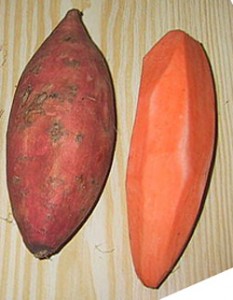 Sweet potatoes contain 65 percent of the minimum necessary daily amount of vitamin C for humans. Sweet potatoes are also high in calcium, folate, potassium and beta-carotene with as much as 700 percent of the US RDA for vitamin A. While they are sweet to the taste, they have a low glycemic index, making them much better than offering regular potatoes for your feathered friends! Research has shown that extracts from sweet potatoes can significantly increase blood levels of adiponectin. Adiponectin is a protein hormone produced by our fat cells, and it serves as an important modifier of insulin metabolism.
Sweet potatoes contain 65 percent of the minimum necessary daily amount of vitamin C for humans. Sweet potatoes are also high in calcium, folate, potassium and beta-carotene with as much as 700 percent of the US RDA for vitamin A. While they are sweet to the taste, they have a low glycemic index, making them much better than offering regular potatoes for your feathered friends! Research has shown that extracts from sweet potatoes can significantly increase blood levels of adiponectin. Adiponectin is a protein hormone produced by our fat cells, and it serves as an important modifier of insulin metabolism.
Anthocyanin and other color-related pigments in sweet potato are equally valuable for their anti-inflammatory health benefits. In animal studies, reduced inflammation following sweet potato consumption has been shown in brain tissue and nerve tissue throughout the body. So feeding them at other times of the year can aid in maintaining health.
4. Green beans
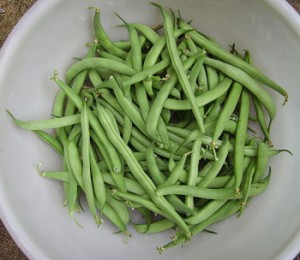 Green beans, while not technically a fall vegetable, often grace our Thanksgiving tables. Green beans also offer a powerhouse of nutrition. Green beans contain excellent levels of vitamin A and the flavonoid polyphenolic antioxidants, including lutein zeaxanthin and ß-carotene!
Green beans, while not technically a fall vegetable, often grace our Thanksgiving tables. Green beans also offer a powerhouse of nutrition. Green beans contain excellent levels of vitamin A and the flavonoid polyphenolic antioxidants, including lutein zeaxanthin and ß-carotene!
A Wild Turkey Story!
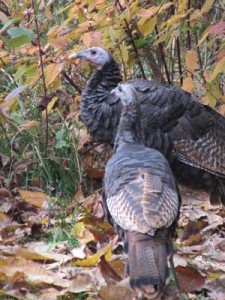 Many know that I have a special bond with the wild turkey. I have a number of wild turkeys on my farm in Ohio that have become my friends! It has been a great honor to watch and observe them over the years, but it has also been very hard. This summer, the local wildlife rehabilitation center called because a good Samaritan had rounded up some baby turkeys that were huddled on the road around their dead mother. The local center sent them over to my avian hospital so that we could care for them. While I had raised turkey polts in the past, this was a significant challenge, as they would not eat the turkey crumbles that we commonly feed. They had lived with mom turkey long enough to imprint on wild foods. But I could not figure what to give them, even though I collected a variety of foods that I had seen my turkeys eat on the farm! And there were other medical issues that we attended to and my staff was very involved in saving their lives. After several weeks of intense care, we were able to successfully feed them the turkey mash and other common grains and plants.
Many know that I have a special bond with the wild turkey. I have a number of wild turkeys on my farm in Ohio that have become my friends! It has been a great honor to watch and observe them over the years, but it has also been very hard. This summer, the local wildlife rehabilitation center called because a good Samaritan had rounded up some baby turkeys that were huddled on the road around their dead mother. The local center sent them over to my avian hospital so that we could care for them. While I had raised turkey polts in the past, this was a significant challenge, as they would not eat the turkey crumbles that we commonly feed. They had lived with mom turkey long enough to imprint on wild foods. But I could not figure what to give them, even though I collected a variety of foods that I had seen my turkeys eat on the farm! And there were other medical issues that we attended to and my staff was very involved in saving their lives. After several weeks of intense care, we were able to successfully feed them the turkey mash and other common grains and plants.
When they grew to about a third of their adult height, I put them in a cage where the other wild turkeys would congregate so that they could learn more on how to “talk turkey” and recognize flock members. It was interesting to observe the wild hens and the interest they showed in them. Then when they were closer to adult height, I decided to let them go, hoping the wild flock would adopt them but that has been sporadic at best. They have had to learn about their surroundings and how to roost in tall trees. So far as Thanksgiving is approaching — they are doing well. As the hens and toms start to flock in the fall, they can be seen with a group of hens on occasion. I am hoping that all goes well this winter. And I will have a very special Thanksgiving, savoring the fact that my flock has had a great present — four new earth eagles!






Enjoyed the story about the wild turkeys. There was a pair of brothers that I knew since they were little beige babies coming with their mother for 5 years and I became fond of them. One night about 4 months ago some coyotes came by and “massacred” all the local turkeys including the two brothers. The next morning all was quiet and no turkeys came down from our trees. It was so sad! I understand that the coyotes were hungry but now I am careful not to get attached to the smaller lavendar ones that have come into the area and replaced them. They are indeed friendly fowl and easy to enjoy!